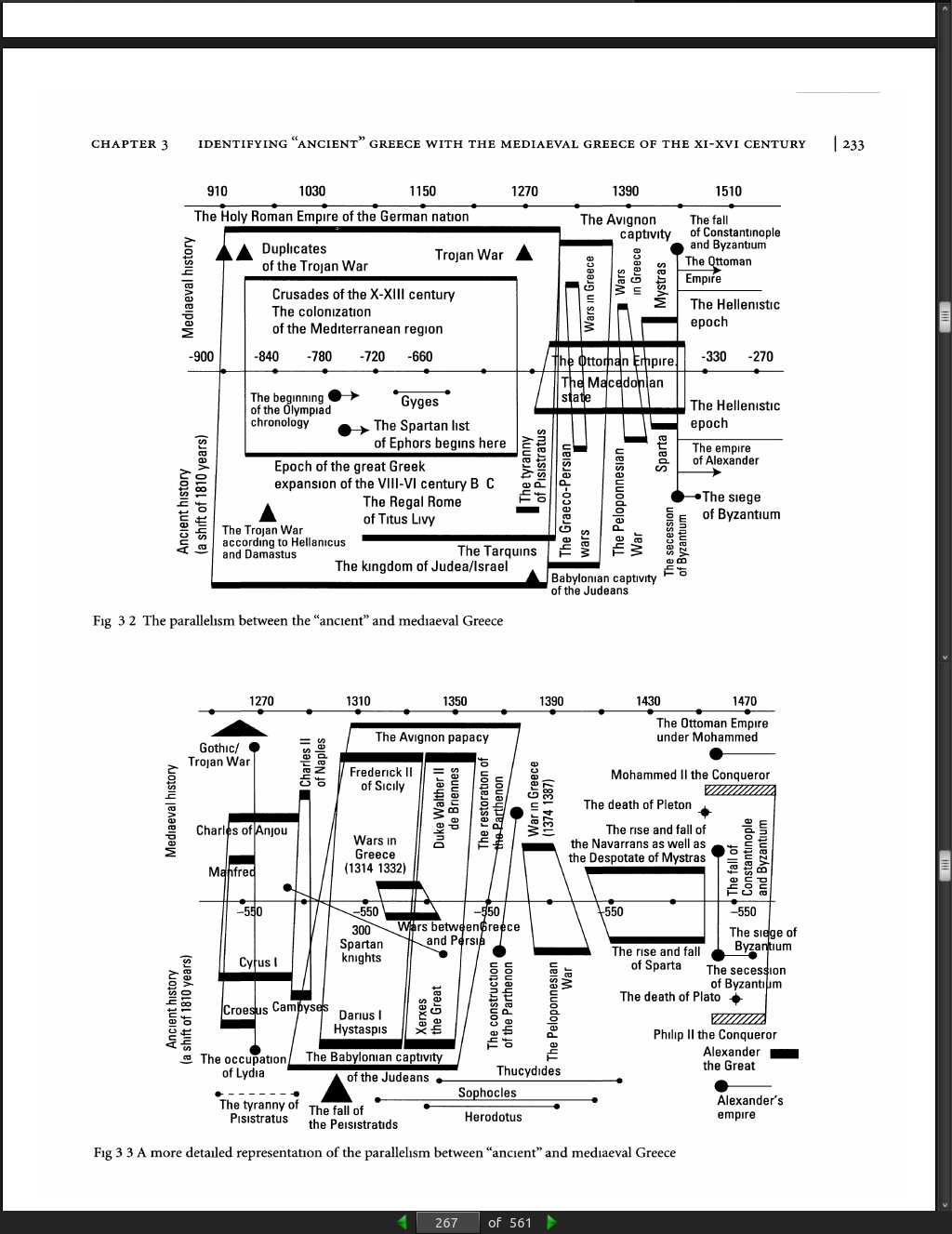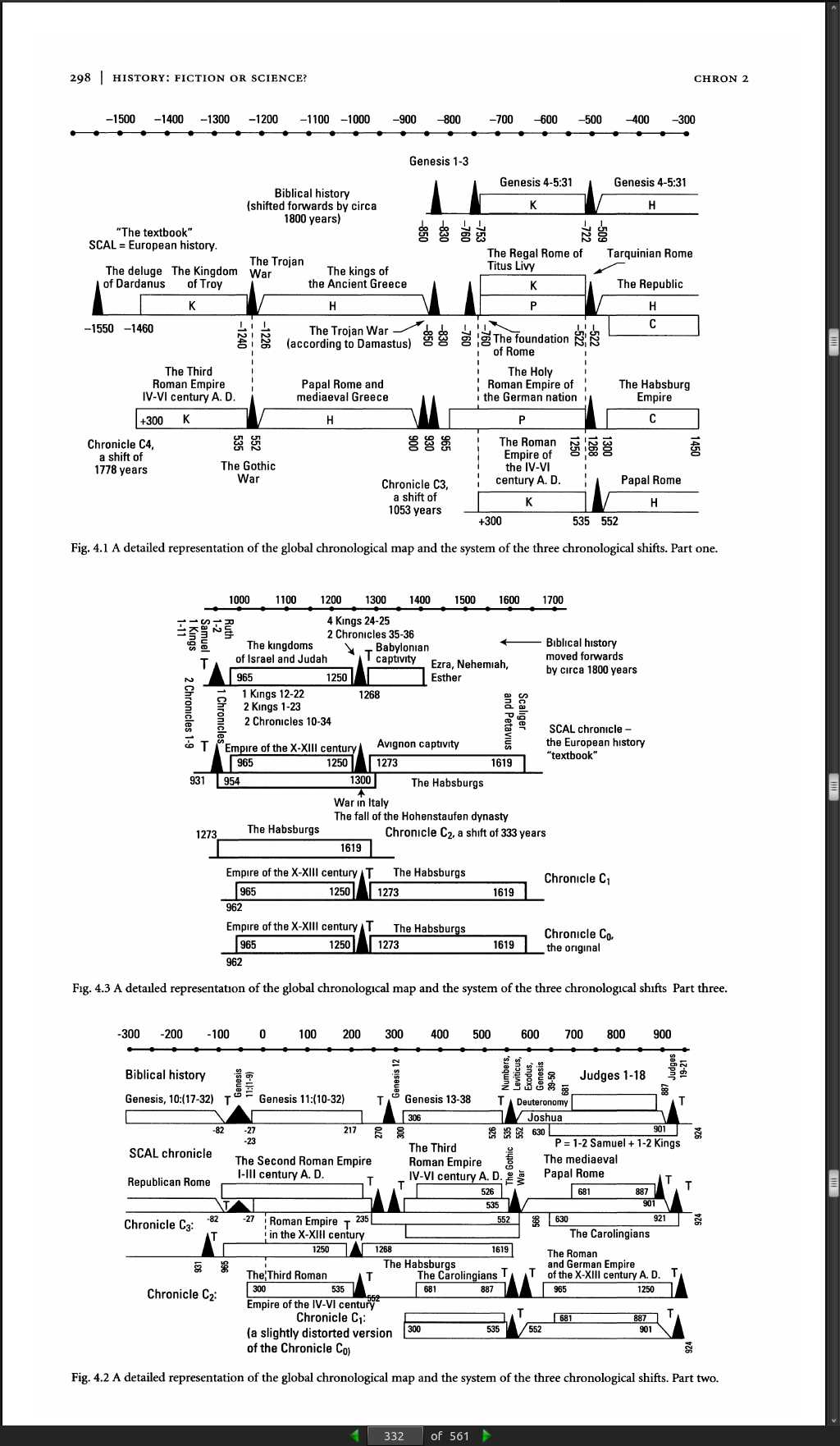Home · Book Reports · 2018 · Chronology 2 - History - Fiction or Science?

- Author :: Anatoly T. Fomenko
- Publication Year :: 2005
- Read Date :: 2018-02-20
- Source :: Chronology_2_Anatoly_Fomenko-History__Fiction_or_Science-(2005).pdf
designates my notes. / designates important.
Thoughts
Personal Feelings
This volume was less appealing for me to read, but that is only because of my disliking its particular structure and has nothing to do with the quality of the content. Sections of chapters read as parallel timelines between era Fomenko claims to be copies of one another. Each section is further divided into a number of small bits that each give one example of this parallelization. Some of my difficulty in reading this was a ignorance of some of the eras plus a lack of interest in much of the details. Again, this does not make the book bad, quite the contrary I think it is excellent, but simply not my cup of tea when it comes to presentation. Someone more intimately familiar with the history in question would probably take to this work like a fish to water. In many cases I did have some idea of the history, particularly the works of Homer and some of the Biblical stories; there were much more enjoyable and interesting to read. Much of these details, besides those that originate from the works themselves, were recounted by historian F. Gregorovius. He makes a great many remarks about the similarities in ancient and mediaeval history while never quite making the leap from his believe in Scaligerian chronology to the, unbelievable to many still, idea that these many of these events could be one in the same. All in all I think this would be a great resource to someone who was more familiar or studying these potentially duplicate events in great detail.
More Questioners
Beyond the scholars mentioned in volume 1, Fomenko points out even more people have been questioned the validity of the Scaligerian Chronology. Jean Hardouin (1646-1729) criticized “ancient” chronology and insisted that the destruction of Jerusalem and Troy were one and the same. His works were banned by the Church in 1739-1742. Robert Baldauf believes that “Our Romans and Greeks have been Italian humanists.” All of them - Homer, Sophocles, Aristotle, and many other “ancient” authors came from Italy of the 14-15th century. Wilhelp Kammeier, a German critic of historical sources lived sometime between 1890/1900 and 1959. He was a lawyer and worked in a Hanover notary. In 1923 he became interested in old documents and in 1926 completed the 292-page manuscript “The Universal Falsification of History.” Like the rest of the critics, he had trouble publishing the work (done in 1935) and was refused the audience of the Prussian Academy historians on the basis that he did not hold an academic office.
Crucifixion
The solar eclipse described during the Crucifixion was solar and lasted about 3 hours according to Matthew, Luke, and Mark. Since a solar eclipse will only last a few minutes it was puzzling. Matthew and Mark say the “darkness all over the land” and “darkness all over the whole land”. If you calculate the time the shadow passed over land, from England to Iran it would be 3 hours and 5 minutes. This shows that the Gospel authors had a great understanding of astronomical calculations. This is confusing if we are to believe they lived 2000 years ago, but not confusing at all if we assume they lived in the 12th century.
If this is the correct dating is then becomes perfectly reasonable to assume that “the fall of Troy is the fall of the New Rome = Constantinople = Jerusalem as a result of the crusader invasion of the 13th A.D. … the crusaders were avenging the Crucifixion of Christ that took place in Czar-Grad in 1185” and that St. Basil might be a reflection of Jesus Christ.
Homer and Troy and Agamemnon Oh My!
The story behind how Homer’s epics were passed down is hard to swallow. He was blind so he had to memorized them (~700 pages of a modern book). The audience memorized them by his performances and passed them down for centuries before they were ever recorded.
Later Latin versions are found as the “originals”. Dares and Dictis wrote, dryly, about the Gothic War, outlining much the same thing as Homer, but they are deemed forgers.
Schliemann “discovers” Priam’s gold and Agamemnon’s mask, but he has no proof, in 1873. He was in contact with a jeweler and requested faux “ancient jewelery”. Many 19th century sceptics wouldn’t believe a word of it while the Scaligerites ate it up as proof. This particular part of the story reminds me of the Piltdown Man hoax. How easy would it have been to forge these stories a century or more ago?
The story of the Trojan horse is almost certainly a fantasy. There is a similar story in the Gothic War where the soldiers entered the sieged New Rome (Constantinople?) via an abandoned aqueduct. The soldiers opened the gates and the city fell. Could these be the same event distorted through time? These theme of a siege, a city taken by guile concerning horses, aqueducts, and canals is common to the Gothic War, the Tarquinian War, Constantinople falling to the crusaders, and the Judean war of Flavius in addition to the well known Trojan War.
Interestingly, the Latin for water is aqua, for horse equa. Could this simply be a distortion in translation? Later authors, when reading about “entering via a horse” and not an aqueduct would have had to make due with what data was available and concoct a story to fit - the giant horse.
Fomenko concludes, “Our reconstruction is as follows: the Trojan War had been a famous mediaeval event, possibly dating from the 13th century A.D., also known as 1) the Gothic War; 2) the Tarquinian War; 3) the destruction of Constantinople (or the New Rome) by the crusaders in 1204 A.D.; 4) the Judean war of Joseph Flavius. The city of Troy is most likely to be identified as the New Rome = Constantinople.”
Same Same
In a most ridiculous contortion, Gregorovius says that the 13th century Pope (Boniface 8th) lived his life in accordance with ancient events. He woke up early to read in his ancient books what was to be done that day and this is why his history so closely mimics Sulla. Or maybe Sulla, whom was supposedly emulated was actually a paralleled in Boniface the 8th?
Another recurring theme is the legend of a woman (possibly a religion) that we see in Helen in Trojan War, the rape of Lucretia in the Tarquinian War, and the murder of Amalasuntha in the Goth War.
We also can see that, like the possible aqua/equa error that gave rise to the myth of the Trojan horse, other words could have been easily mis interpreted leading to very different interpretations for later readers. One example is the hetera (cavalry leader) Antonius that seems to have been transformed into Antonine the hetera (prostitute).
In one of the most iconic battles, the 300 Spartans facing the Persian hordes, we see that there is a parallel in the 300 knights of Jean de la Roche in the 14th century. In both battles the defending leader said similar things: “great are their numbers but few of them are true men” -the duke and “the Persians are great in numbers but true men are far and few” -Herodotus writing. The Scaligerian story is that the duke found himself in the same situation in the same region and recited Herodotus.
The duplicate history continues, in a most galling manner, when one examines Plato and Gemisto Pleton; both philosophers, writers, and public figures. According to Fomenko, the Latin word geminus translates as “double”, “twin”, “one item in a pair”, or “spitting image”. Therefore, “Gemisto Pleton” can translated as “Plato’s double”. If this isn’t enough we can see that Pleton and Plato wrote extremely similar works, but Pleton’s “The Doctrine of Statehood” was incinerated and lost, but Plato’s “Republic” survived for centuries. Last, but not least, we see that there were in fact three duplicates of the well known philosopher; Ancient Plato in the 5th century B.C.; ancient Plotinus in the 3rd century A.D. ; and “modern” Pleton in the 15th century A.D. Surely these are all nothing but coincides…
A few other parallels that are covered throughout the book include the belief that Adam and Eve, Paris and Helen, Perseus and Andromeda, Jason and Medea, and St. George and the princess are all copies of the same story, and that Sodom and Gomorrah may have been destroyed by Vesuvius’ eruption of 1138-1139.
A final interesting parallel can be found in the stories of Abimelech (Judges) and Pyrrhus. Both killed when a woman throws a stone/tile and hits them on the head. They, being mortally wounded, ask to be killed by a soldier so that they are not slain by a woman. The original of both of these is probably Count Simon de Montfort who was killed in alleged year 1218 A.D. “He was killed by a shot from the catapult that occupied a stratefic position on the walls of Toulouse, which was served by maids and woman according to folk tradition” [1020 pg 27].
Misc
There are a few other, somewhat random, interesting points I found within the pages of this book. The first is a propaganda image showing Ottoman Empire warrior with a baby run through one his lance and 2 slaves. This picture reminds me of the WW1 propaganda depicting Germans as gorillas and killing babies.
The second is that very little middle ages Greek literature has survived, but loads of ancient literature has. Could this be that the “ancient” artifacts are actually from the middle ages?
Third is that logarithms, invented either in the Netherlands in 1620 or in China 500 years earlier. What is most odd is that a misprint of Napier’s table of natural logarithms (1620) is repeated in the Chinese version presumed to be 500 years older. It could also be that Napier’s is the copy of a Chinese original. Either way, the same misprint in a book of a rather esoteric topic is almost certainly not chance.
And lastly, Fomenko asks, do the readers know many facts concerning the biography of their grandparents, let along great-grandparents, unless there are written sources remaining in family possession? While this is no evidence in and of itself for the veracity of Fomenko’s theory, it is food for thought. We know very little of what happened even a few generations ago. Why would we assume that there is somehow accurate historical knowledge spanning hundreds or thousands of years?
Exceptional Excerpts
Table of Contents
- Ages in Chaos
- Preface
- 01: The Middle Ages referred to as the 'Antiquity'
- 02: The Famous Reforms of the Occidental Church in the 9th century by 'Pope Gregory Hildebrand as the reflection of the 113th century reforms of Andronicus (Christ). The Trojan War of the 13th century A.D.
- 03: Identifying "ancient" Greece as the medieval Greece of the 11-16th century with the chronological shift of 1800 years taken into account
- 04: Superimposition of the Bible over phantom and real Eurasian events of the Middle Ages after a shift of 1800 years
- Pages numbers from pdf. Actual page numbers minus 33-34 (there is one page duplicated somewhere in the middle of the pdf).
· Ages in Chaos
- by Dr. Eugen Gabowitch
page 16:
- Logarithms, invented in the Netherlands supposedly were invented in China 500 years earlier. Odd that a misprint of Napier’s table of natural logarithms (1620) is repeated in the Chinese version presumed to be 500 years older.
page 17:
- Much of China’s history has been taken from translated European texts that are lost in translation and become Chinese myth.
page 19:
- Jean Hardouin (1646-1729) criticized “ancient” chronology and insisted that the destruction of Jerusalem and Troy were one and the same. His works were banned by the Church in 1739-1742.
page 20:
-
Robert Baldauf believes that “Our Romans and Greeks have been Italian humanists.” All of them - Homer, Sophocles, Aristotle, and many other “ancient” authors came from Italy of the 14-15th century.
-
Wilhelp Kammeier, a German critic of historical sources lived sometime between 1890/1900 and 1959. He was a lawyer and worked in a Hanover notary. In 1923 he became interested in old documents and in 1926 completed the 292-page manuscript “The Universal Falsification of History.” Like the rest of the critics, he had trouble publishing the work (done in 1935) and was refused the audience of the Prussian Academy historians on the basis that he did not hold an academic office.
· Preface
page 24:
- The leap in the theory of lunar motion’s parameter D`` was between the 8-10th centuries.
page 26:
-
Let us emphasize that the new concept of chronology is based primarily on applying methods of modern statistics to the analysis of historical source and extensive cybernetic computations.
-
Cybernetic computations?
page 35:

· 01: The Middle Ages referred to as the ‘Antiquity’
Mutual Superimposition of the Second and Third Roman Empire, both of which identified as the respective kingdoms of Israel and Judah
page 64:
- Bear in mind that the parallelism between the Israelite Kingdom and the Third Roman Empire is of a secondary nature, being but a reflection of more fundamental parallelisms that we shall relate in the chapters to follow.
page 65:

page 78:
-
Kingdom of Israel (922-724 B.C.) can be identified as 3rd Roman Empire (306-476 A.D.). Kingdom of Judah (928-587 B.C.) cab be identified as the Eastern Roman Empire (306-700 A.D.).
-
These are still both derivatives of the German/Roman parallel. Particularly the coronation of the Sacred Empire of 10-13th century A.D. and the empire of the Habsburgs of the 14-16th century.
- The Theomachist Kingdom of Israel duplicates the Roman coronation sequence of the Holy Roman Empire 10-13th. The Theocratic Kingdom of Judah duplicates the German coronations in the Holy Roman Empire 10-13th. Both kingdoms of Israel and Judah are, to a substantial extent, phantom reflections of the Habsburg Empire of 14-16th century A.D.
page 79:
- St. Basil seems to be a reflection of Jesus Christ.
· 02: The Famous Reforms of the Occidental Church in the 9th century by ‘Pope Gregory Hildebrand as the reflection of the 113th century reforms of Andronicus (Christ). The Trojan War of the 13th century A.D.
page 86:
- The solar eclipse described during the Crucifixion was solar and lasted about 3 hours according to Matthew, Luke, and Mark. Since a solar eclipse will only last a few minutes it was puzzling. Matthew and Mark say the “darkness all over the land” and “darkness all over the whole land”. If you calculate the time the shadow passed over land, from England to Iran it would be 3 hours and 5 minutes. This shows that the Gospel authors had a great understanding of astronomical calculations. This is confusing if we are to believe they lived 2000 years ago, but not confusing at all if we assume they lived in the 12th century.
page 140:
- 74% of Livy’s account of the Tarquinian War 6th century B.C, coincides with the Gothic War 6th century A.D.
page 147:
-
Parallels between the Trojan War (12th B.C.) and the Gothic War (6th A.D.) and the crusade epoch wars (11-13th A.D.)
-
the Trojan and Gothic Wars are most likely to be phantom reflections of real wars that took place in the crusade epoch (11-13th A.D.)
-
Homer tells a compound myth describing the crusades of the Middle Ages
-
the fall of Troy is the fall of the New Rome = Constantinople = Jerusalem as a result of the crusader invasion of the 13th A.D. … the crusaders were avenging the Crucifixion of Christ that took place in Czar-Grad in 1185.
-
Graeco-Roman shift of 330-360 years.
-
Roman shift of 1053 years.
-
Graeco-Biblical shift of 1780-1800 years.
page 151:
- The story behind how Homer’s epics were passed down is hard to swallow. He was blind and memorized them (~700 pages of a modern book) and performed them. The audience memorized them and passed them down for centuries before they were recorded. Later Latin versions are found as the “originals”. Dares and Dictis wrote, dryly, about the Gothic War, outlining much the same thing as Homer, but they are deemed forgers.
page 152:

page 155:
-
Schliemann “discovers” Priam’s gold and Agamemnon’s mask, but he has no proof, in 1873. He was in contact with a jeweler and requested faux “ancient jewelery”. Many 19th century sceptics wouldn’t believe a word of it. The Scaligerites ate it up as proof.
-
This reminds me of the Piltdown Man hoax.
page 158:

page 180:

page 183:

page 186:
- The story of the Trojan horse seems fantasy. There is a similar story in the Gothic War where the soldiers entered the sieged New Rome (Constantinople?) via an abandoned aqueduct. The soldiers opened the gates and the city fell. Could these be the same event distorted through time?
page 187:
- The Latin for water is aqua, for horse equa.
page 187:

page 189:
- Achilles = Valerius, Patroclus = Brutus.
page 191:
- Achilles = Belisarius, Hector = Gothic king Vittigis
page 203:
- Our reconstruction is as follows: the Trojan War had been a famous mediaeval event, possibly dating from the 13th century A.D., also known as 1) the Gothic War; 2) the Tarquinian War; 3) the destruction of Constantinople (or the New Rome) by the crusaders in 1204 A.D.; 4) the Judean war of Joseph Flavius. The city of Troy is most likely to be identified as the New Rome = Constantinople.
page 217:
- Janius Brutus, son of Marcus, the liberator of the Romans from the Tarquinian tyranny, and Junius Brutus Marcus who delivered the Romans from the tyranny of Julius Caesar. [were often confused because they are likely duplicate of on another, one cast back in time via Scaligerian chronology.
page 224:
- Gregorovius says that the 13th century Pope (Boniface 8th) lived his life in accordance with ancient events. He woke up early to read in his ancient books what was to be done that day. Or maybe Sulla, whom was supposedly emulated was actually a paralleled in Boniface the 8th?
page 231:

page 234:

page 238:

page 239:

page 248:

· 03: Identifying “ancient” Greece as the medieval Greece of the 11-16th century with the chronological shift of 1800 years taken into account
page 267:

page 268:
- The legend of a woman (religion) Helen in Trojan War, rape of Lucretia in Tarquinian version, murder of Amalasuntha in the Goth War.
page 289:
- Cavalry leader (“hetera”) Antonius transformed into Antonine the hetera (prostitute). Chapter 2, Chronology 2
page 296:
-
300 Spartans = 300 knights of Jean de la Roche in the 14th.
-
In both battles the defending leader said similar things: “great are their numbers but few of them are true men” -the duke and “the Persians are great in numbers but true men are far and few” -Herodotus writing. The Scaligerian story is that the duke found himself in the same situation in the same region and recited Herodotus…
page 297:
- Persians = Franks/French = Ottomans Turks = Tartars
page 304:
- Plato and Gemisto Pleton; both philosophers, writers, and public figures.
page 305:
- Latin word geminus translates as “double”, “twin”, “one item in a pair”, or “spitting image”. Therefore, “Gemisto Pleton” can translated as “Plato’s double”…
page 306:
-
Pleton’s “The Doctrine of Statehood” was incinerated and lost, but Plato’s “Republic” survived for centuries.
-
Ancient Plato = 5th B.C. ; ancient Plotinus = 3rd A.D. ; “modern” Pleton = 15th A.D.
page 317:
- The Macedonian conquest (4th B.C.) is paralleled to the Ottoman conquest of 15th A.D.
page 319:

page 325:
-
Propaganda showing Ottoman Empire warrior with a baby run through one his lance and 2 slaves. This picture reminds me of the WW1 propaganda depicting Germans as gorillas and killing babies.
-
The stereotypical bust of Alexander, looking Dionysiun (and like Jim Morrison).
page 325:

page 328:
- Very little middle ages Greek literature has survived, but loads of ancient literature has. Could this be that the “ancient” artifacts are actually from the middle ages?
King Croesus as Manfred
King Cyrus I as Charles of Anjou
King Cambyses as Charles II of Naples
King Darius I and Frederick II
King Xerxes as Walther II Herzog
page 329:

page 330:

· 04: Superimposition of the Bible over phantom and real Eurasian events of the Middle Ages after a shift of 1800 years
page 333:

page 336:

page 341:
- Adam and Eve = Paris and Helen = Perseus and Andromeda = Jason and Medea = St. George and the princess
page 355:
-
F. Gregorovius wrote that “according to the most recent research, the ancient legend of Saturn is supposed to explain the name of Rome and the story of its foundation, since Remus (or Romus)… happens to be the Semitic name of Saturn, ‘The Greatest’, and corresponds to the Syrian Ab-Rom, Abu-Rom and Baal-Ram” [196 vol 3, pg 461, comment 26]
-
“Whoso sheddeth man’s blood, by man shall his blood by shed” (Genesis 9:6)
-
“Whomsoever lays his hand on a man and slays him, be he also slain” (Exodus 21:12)
page 360:
- the two Biblical kingdoms [of Lot and Abraham] can be identified as the Italian and German dynasties of the Holy Roman Empire of the alleged 11-13th A.D. and the Habsburg = “Mongolian” Empire of the 14-16th A.D.
page 361:
- Sodom and Gomorrah destroyed by Vesuvius’ eruption of 1138-1139.
page 367:

page 372:

page 378:
- Do the readers know many facts concerning the biography of their grandparents, let along great-grandparents, unless there are written sources remaining in family possession?
page 387:
- Abimelech (Judges) and Pyrrhus are both killed when a woman throws a stone/tile and hits them on the head. They, being mortally wounded, ask to be killed by a soldier so that they are not slain by a woman.
page 388:
- The original of both of these is probably Count Simon de Montfort who was killed in alleged year 1218 A.D. “He was killed by a shot from the catapult that occupied a stratefic position on the walls of Toulouse, which was served by maids and woman according to folk tradition” [1020 pg 27]
page 392:

page 403:

page 405:

page 407:

page 416:

page 431:
